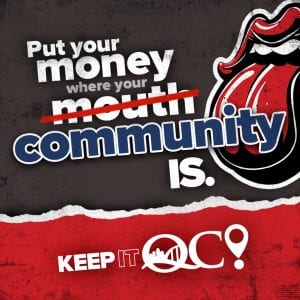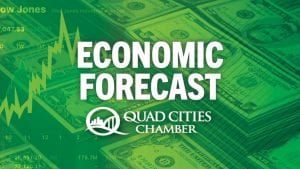Quad Cities Chamber Forecast Predicts “Hot” Economy for 2021
There are just 28 days left in this nightmare of a year. But will 2021 really be much better?
Yes, but we’ll need to be patient, according to an economic forecast Thursday presented by the Quad Cities Chamber of Commerce.
“Pivot and acceleration are two new favorite words in our dictionary,” Paul Rumler, chamber president/CEO, said before the formal virtual presentation, done online.
“The Quad Cities Chamber has pivoted very aggressively this year to meet the increased demand,” he said. “We are so gratified to hear about

The Quad Cities Chamber is promoting a “Keep It QC” to boost local spending.
your resiliency and determination to fight through 2020, and be prepared for a better year ahead.
“We’ve helped hundreds of businesses – whether it be through building connections with your clients and customers, or advocating for assistance at the state or federal level, or guiding you through the nuance and complicated matrix of filling out financial information,” he said. “Our team stands ready to help you out.”
“I remain very bullish and excited about the Quad-Cities’ future,” Rumler said. “We are still a very attractive place to do business. We’re seeing that. Coming into this year, the Quad-Cities was rated number seven in the Midwest, number one in the entire state of Iowa for our economic strength. We continue to be identified as the third-most diversified economy in the entire country.”
The Q-C has been seeing different activity this year, more in mergers and acquisitions, he said. “It’s really gratifying to see local companies and local investors buying and purchasing and investing in local companies.” Rumler said.
“The flipside to that is seeing investors and companies from outside the area buying companies, and that threatens the stability of our market, because those jobs could be moved elsewhere,” he said.
There’s been increase in business attraction activities, mostly in manufacturing and food-production industries, Rumler said. “We think that we have good times ahead based on our pipeline,” he said.

Paul Rumler is president/CEO of the Quad Cities Chamber.
He also promoted the chamber’s new “Keep It QC” campaign, by asking businesses to look at their supplier base and vendors, who they’re doing business with.
“If you can identify some you’re doing business with outside the Quad-Cities market – maybe it’s a law firm in Chicago or an accounting firm in California,” Rumler said. “Move that work here to the Quad-Cities; see what you can do.”
“We know that our restaurants and retailers are extremely challenged right now,” he said. “We need you to go above and beyond, to help them support them through this challenging time.”
Rumler mentioned the Keep It QC gift card program, encouraging people to shop with local businesses, and purchase the card as gifts for employees and clients.
The chamber has produced their first quarterly market report in November, available at https://quadcitieschamber.com/economic-development/quarterly-market-report.
“The Quad-Cities community has fared better than other communities across the nation through the third quarter of 2020,” the website says.

Kevin Depew is RSM’s deputy chief economist.
“Some sectors continue to be very challenged, particularly the food and beverage establishments and retail businesses.”
Two new bright spots are new Q-C restaurants opening this week. Bad Boyz Pizza will reopen its Davenport location, this Friday at 3 p.m. – at 4706 Utica Ridge Rd., just down the block from its previous location.
On Thursday, Meli’s Pancake House opened in Moline, at 1320 5th Ave. (former Barley & Rye) in downtown Moline. It serves some of the freshest breakfast and lunch options from 6 a.m. to 3 p.m. and are available for carry-out and delivery.
The Q-C region he region experienced a substantial loss in economic activity in April, and the worst of the economic crisis occurred in the middle to end of April, the chamber report said.
By the end of June, the regional economy was estimated to have recovered about 62% of the loss it experienced during the early weeks of Covid. Part of this recovery was likely due to the massive stimulus received in the region, the report said.
Businesses in the area received between $312 million and $593 million in Paycheck Protection Program loans, and the region received around $300 million in stimulus checks. During the third quarter, the recovery slowed down considerably, with the index growing about one-sixth as fast as it did in Q2.
“At its current growth rate, we estimate that the local economy will not reach Q1 2020 levels until the end of 2021,” the chamber said.
“As the region moves into the fourth quarter, uncertainty regarding the virus’s path, prospects for vaccines or therapeutics for patients, and a further economic stimulus from Washington weigh on expectations for future economic growth. Most economists expect a somewhat more ‘normal’ period of growth, but this may change dramatically depending on the virus and stimulus.”
In the Q-C area, the unemployment pattern followed the nation — 15.3% in April, 11.5% in June, and 7.1% in September. The metro area lost 10.7% of its nonfarm payroll jobs in April, recovering about one-third of that by June, the chamber said.
Job growth stagnated during the third quarter in the area, growing by less than 1% from June to September. Over the course of the third quarter, the area averaged 34% fewer claims than the national average.
RSM presentation reflects national, regional trends
The chamber presentation was done by Kevin Depew — RSM’s deputy chief economist and industry eminence program leader, who provides clients with macroeconomic and industry perspectives and insights they need to successfully manage their businesses.

The Q-C Chamber presented its annual economic forecast on YouTube.
Depew leads the firm’s newly-created industry eminence program and helps train RSM senior analysts in industry analysis with an emphasis on how artificial intelligence, machine learning and data will reshape RSM’s clients’ industries.
The national economy has proven resilience, and is getting close to the reactivation phase, leading to reimagining of the economy, he said. “I think that’s really exciting. It’s just unfortunate that the crisis continues to be so severe.”
“We still have to deal with what promises to be a particularly dark winter,” Depew said. “There is at least light at the end of the tunnel, and the light is not from an oncoming train. There’s some real progress we’ve made, not only in being able to treat coronavirus, but also on the vaccine front.”
Areas that are most resilient to date are housing and manufacturing, which together only account for 17 percent of the U.S. economy, Depew said.
Ruhl&Ruhl Realtors recently reported that Q-C home prices have increased 2.1 percent over the past year, and 13.6 percent in the past five years.
Housing in the U.S., trends that the pandemic accelerated were in place prior to the onset of Covid, Depew said, noting that also applies to technology and telework trends.
“In all, 2021 should be a good year,” he said, noting there are still risks of business curtailment due to restrictions to slow the virus spread. By this February, Depew estimated there may be a total of 500,000 U.S. deaths from Covid; as of Thursday, at least 273,500 have died, according to a New York Times database.
Case numbers are spiking across most of the U.S., leading to dire warnings about full hospitals, exhausted health care workers and expanding lockdowns. Covid hospitalizations just topped 100,000 nationwide for the first time and Wednesday’s national death total (2,885) was the

Depew gave an optimistic forecast for 2021 on Thursday.
highest since the start of the pandemic.
“Obviously, in the second quarter, there was a historic decline in GDP,” Depew said of gross domestic product, noting a 31.4 percent drop, followed by 33-percent rebound in the third quarter.
“Our forecast for Q4 is a little more subdued, at 2.75 percent,” he said. “But when we look at 2021, our full year forecast is about 3.5 percent – and that’s subject to upward revisions.”
That’s a better long-term growth trend than decades past, Depew said. From 1945 to 2007, that trend in the U.S. economy averaged 2.5 percent growth per year. Prior to the pandemic, that growth path was 1.8 percent per year.
Before the pandemic, the nation had historically low unemployment, with 3 percent in most major metro areas, and the Q-C a little higher, about 4 percent, Depew said.
Now, there’s a national average of two unemployed people for every job opening, compared to the last recession in 2009, when it averaged 6.5 unemployed for every opening, he said.
“There are still 10 million people who are directly unemployed as a result of the pandemic,” Depew said. “The overwhelming majority of

Rumler spoke at the outset of Thursday’s economic forecast.
those jobs tended to be lower income, lower-wage jobs, that typically paid minimum wage. As those start to come back, we’ll see employment start to rapidly increase, but it’s not going to solve some of the labor challenges that were present prior to the pandemic.”
With policy at the federal level, he recommended another round of major financial aid in Covid relief. “What we saw in the spring of this year, in terms of fiscal policy, that was not stimulus,” Depew said. “Those were emergency stopgap measures to be able to help households get through the traumatic loss of income.”
“It was also, things the Federal Reserve did was to help businesses get past what was a temporary shutdown in the economy,” he said. “We actually haven’t gotten to the stimulus part yet — the part that really helps the economy move from recession to growth, approaching 3.5 percent for next year.”
A bipartisan group of lawmakers outlined a temporary $908 billion coronavirus relief proposal on Tuesday, far less than Democrats had hoped for, aimed at breaking a stalemate that has persisted for months.
The proposal, which includes more unemployment benefits, must still get the approval of Republican and Democratic leadership and is designed to include elements that will satisfy both parties, according to NBC News. It doesn’t include some popular provisions, like another round of direct payments to families, and lasts through March 31.
The plan was described as a “bridge” and faces a steep uphill climb as party leaders remain far apart on the price tag and details. In recent months, House Democrats have passed a $2.2-trillion relief package while Senate Republican leaders have pursued a $500 billion package that has faltered amid a lack of bipartisan support.
Senate Majority Leader Mitch McConnell said Tuesday he’s working with the White House to see what the president will sign on Covid-19 relief. He also said he plans to attach any agreement to a government funding bill ahead of the Dec. 11 deadline to avoid a shutdown.
The new Biden administration will mend fences with U.S. trading partners, Depew said. “There’s no question a lot of that is cosmetic and superficial – relating to how we talk to our trading partners, how polite we are. All those things that the Trump administration didn’t feel like was very necessary. It just means we’re reducing trade friction overall.”
The China tensions will likely remain, he said. “You can start a trade war overnight with tariffs, but the ability to extricate yourself from the trade war is much more challenging and takes a much longer time,” Depew said. “I would not look at the Biden administration coming in, with an end to the tariffs or we’ll see new negotiation with China beyond what’s already in place.”
Persistently high unemployment claims
The initial new jobless claims reported Thursday were 711,000 in the U.S., below the 780,000 that economists were forecasting, Depew said. The four-week average is 742,000 claims, compared to 210,000 per week prior to the pandemic, he noted.
The two prior worst weeks in the U.S. were in 1982, with 656,000 jobless claims filed, and then in 2009, when there were 665,000 claims, Depew said.

Moline-based Deere & Co. reported higher 4th-quarter income this year compared to 2019.
A lot of the current jobless are in the leisure/hospitality sector, and sporting venues, things that are closed now, he said. Others that are high include state and local governments, who’ve seen dramatic revenue shortfalls.
Depew estimates those governments need $600 billion in federal stimulus.
“Once we turn the economy back on and it becomes safe to travel like we used to, or go to sports and hospitality/leisure type events, those jobs quickly come back,” he said, compared to state and local government jobs.
With federal minimum wage, it’s going to have to move up, Depew said. “The reality is, we are probably moving toward $15 an hour at a federal level before the next four years are up.”
The federal minimum wage of $7.25 an hour hasn’t gone up since 2009. Then,. It grew from $5.85 per hour effective July 2007, and $6.55 per hour effective July 2008. In Illinois, the minimum wage is now $10 an hour, scheduled to rise to $11 on Jan. 1, and gradually to $15 an hour by January 2025. Iowa remains at $7.25.
If you operate businesses in both states (like in the Q-C), that makes it very challenging for your labor situation, Depew said. “I think that goes towards accelerating the labor-replacing technologies as a way to combat that $15-an-hour minimum wage. In the near term., the difference between $15 and $7, or a way to withstand a move toward $15, which could double your costs in some cases.”
“That’s a near-term problem, which can be solvable with technology,” he said. “Can we get there longer-term? That’s always the challenge that businesses face.”
With 2021 economic growth, “Businesses that are not actively preparing for a very hot economy in 2021 – even with the pandemic still with us, you need to make those plans right now,” Depew said. “You may be left in the dust by some of your competitors, if they are actively preparing for a hot economy in 2021 and beyond.”
This pandemic is suppressing the recovery that had been in place since the Great Recession, he said.
Timelines for Covid vaccines
As vaccines are introduced next year, that will unlock greater consumer spending, Depew said. “It has the potential to occur all at once,” he said. “Even if the vaccine goes according to how we think it might; if it goes better than we expect – the demand pool, the increase in demand leads to labor challenges.”
That also will allow businesses to increase prices, Depew said.

Meli’s Pancake House in downtown Moline opened Thursday.
He outlined proposed timelines for a Pfizer vaccine, which requires massive coordination on the local, state and federal levels. The first phase of recipients, in the next two months, will be for health-care workers and nursing home residents. From January to May, vaccines will primarily be for the elderly and people with underlying health conditions.
The next phase, from June to October 2021, will be for other essential workers and additional elderly, Depew said. It’s critical for everyone to get a vaccine, since it won’t be effective if, say, 35 percent of the population gets it, he said.
One of the worst features of recovery from the 2008-09 recession was the gap between major cities and rural areas. Depew said after he graduated college in 1992, “no one was ever gonna live in a city again.”
Cities had poor infrastructure, high cost of living, crime, and not enough housing, he said. Now, it’s like no one wants to live in rural areas – with poor infrastructure, technology, no job opportunities, Depew said. “I’m confident you’ll see that urban versus rural divide start to mend, which will have an impact overall, not only on the economy and fortunes of rural areas, but on polarization in general.
“It’s not surprising we have a polarized electorate, when you have everybody in cities think everything’s been great, and everybody in rural areas who think, what are you talking about?” he said.
“We may look back at 2020 as the high watermark in terms of peak polarization,” Depew said. As younger politicians assume leadership roles, the collaboration will define the coming decades, he said.

Bad Boyz Pizza is opening its new Davenport location Friday on Utica Ridge Road.
Innovations in health care and technology also will improve the economy, standard of living and quality of life, Depew said.
The fortunes in the Midwest and Q-C are tied to manufacturing and agriculture, he said. “What I’m very optimistic about are the fortunes of Deere specifically.”
Moline-based Deere & Company reported net income of $757 million for the fourth quarter ended Nov. 1, compared with net income of $722 million for the same quarter last year. For fiscal 2020, net income was $2.75 billion, compared with $3.25 billion in 2019.
Worldwide net sales and revenues decreased 2 percent, to $9.73 billion, for the fourth quarter of 2020 and declined 9 percent, to $35.54 billion, for the full year.
Depew said he’s optimistic for the Midwest since the domination of the major innovation hubs has been decreasing, toward places like Madison, Wis.
“I think the Quad-Cities is positioned to increase some of the diversity of industry there,” he said. “That should accelerate. If anything, the more we get away from being dominated by those major tech innovation hubs, we’ll have more of a fair economy that helps the fortunes of the Midwest specifically.”
Local businesses have to survive the short-term, and there’s no question on the small business side they have been hurt more dramatically and it’s not as well reported, Depew said.
“It’s easy for me to see how the Fortune 1000 has been doing,” he said. “It’s very challenging to go in – you have to go MSA by MSA to see how small businesses are faring. The concern is that there are hidden pockets of insolvency that will be revealed once the macroeconomy starts to look better. There will be a lag between the fortunes of small business and the broader economy.”
“That’s assuming the businesses are able to get through the next six months,” he said. “That’s why the stimulus is so critical.”
Depew is most concerned with federal lawmakers who look at the overall economy, and not so much the small and medium-sized businesses.

The Q-C Chamber presented its annual economic forecast on YouTube.
How is the trend of more people working remotely going to affect the economy?
He said that will mean much a smaller footprint for businesses and offices. Many things we have done in offices, we no longer need to do in offices.
“When I was putting data together for this event, I don’t need to go to an office to do that,” Depew said. “When I’m talking through what this data means to my team, it’s very effective, much more effective to go in and have that collaboration.”
“We’ll see a resurgence in commercial real estate that’s dominated by collaborative environments, changes the layout, the interior footprint,” he said. “It’s going to be a reconfiguration.”
How about the importance of holiday spending going into the new year?
Data from Black Friday and Cyber Monday showed that physical retail establishments without significant online presence won’t be able to make it through, Depew said.
“If we had a holiday shopping season similar to 2018, then that would be a win,” he said. “I’m not seeing that 2019 is doable, but 2018 may be. That takes us into the first quarter, once you get through the winter months, you see more light at the end of the tunnel, the interesting thing about that – that demand materializes overnight. It’s not something that’s a slow burn.”
The National Retail Federation said about 186.4 million shoppers bought holiday gifts, food or decorations from Thanksgiving to Cyber Monday. That’s less than the 189.6 million shoppers who bought items during that period last year, but higher than the 165.8 million who shopped in 2018.
Over this year’s holiday weekend, average spending on gifts, decorations and food was $311.75, down about $50 from last year, the NRF said.
“How you navigate the next six months – it’s going to be critical for consumer products companies,” Depew said Thursday.
“It’s not going to heal all the wounds from this pandemic,” he said of a better 2021. “Certainly, we’ve not gotten to the point where we can comprehend the death toll. There are significant challenges that are still ahead of us. The economy, it will be what the economy is. I think 2021 should be better than we expect. But it’s not going to overnight heal what we’ve been through.”
You can view Depew’s presentation HERE.









